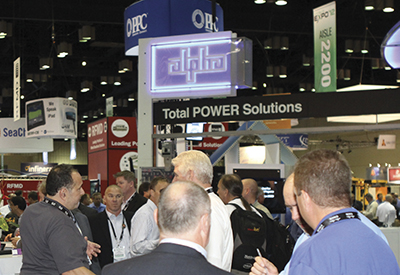SCTE Looks at Cable’s Evolving Tech Landscape

Organizers expect around 10,000 attendees at this year’s Cable-Tec Expo, Oct. 21–24 in Atlanta.
ATLANTA—The shifting focus at the Society of Cable and Telecommunications Engineer’s annual Cable-Tec Expo is a good gauge about what’s important to cable’s technology community. Last year, the emphasis was on wireless, fiber optics and Internet Protocol TV; the previous year it was home networking and the environment.
Hence, this year’s themes of network integration and accelerated deployment reflect the industry’s aggressive push toward fullscale communications services and its “TV Everywhere” objectives. Even the sessions on High-Efficiency Video Coding (HEVC) are motivated by the need to prepare the cable plant for greater integrated demands, according to Daniel Howard, SCTE’s CTO and senior vice president of engineering.
NEW NETWORKS, NEW DEMANDS
Cable-Tec Expo’s agenda for the event, Oct. 21–24 in Atlanta, is also laden with sessions on information technology solutions, “big data” and cloud-based architectures and services.
Kevin Hart, program chair for the show, emphasizes the rationale behind this year’s concentration on IT and next-generation network services, which he says represent the industry’s growing competitive position.
“Configuring cable networks to deliver new types of services is creating the need for increased learning opportunities for cable engineering and operations professionals,” said Hart, who is executive vice president and CTO for Cox Communications.
Cable-Tec Expo is expected to attract about 10,000 attendees, similar to levels during the past few years. Howard noted that international attendance was up about 3 percent last year and that there are expected to be delegates from 70 countries, emphasizing the global growth of wired broadband.
Get the TV Tech Newsletter
The professional video industry's #1 source for news, trends and product and tech information. Sign up below.
Former FCC Chairman Michael Powell, now president/CEO of the National Cable & Telecommunications Association, will kick off the general sessions with a policy-focused presentation, followed by two panels featuring, respectively, the CTOs and CEOs of major cable operators and suppliers.
In addition to dealing with the “four ‘any’s’” of TV Everywhere (any content, any place, any time, any platform), Howard stresses the importance of the industry’s accelerating technology development process.
“We have to know how to ‘scrunch down’ product cycles,” he said. This issue, he notes, is particularly important as the industry deliberates the future of set-top boxes, a topic that will inevitably rumble through the Georgia World Congress Center, site of the Expo.
“You’ve still got two camps,” Howard acknowledges, citing “people who want to put powerful devices in the home [for] remote management of home networks… [and others] who advocate BYOD [bring your own device] and want to put everything in the cloud. The jury is still out.”
Howard also notes that software-defined networks will be part of this discussion at Cable-Tec Expo.
FIVE TARGETED AUDIENCES
SCTE has identified five distinct audiences among its mostly-engineer audience: Radio frequency and optical experts; IP and IT professionals; network and field operations specialists; OSS/BSS (Operations Support Systems and Business Support Systems) personnel; and the emerging new category of applications specialists. Howard says that the program is structured to these sectors, with most sessions repeated at least once to assure that attendees can tune into topics if there is a schedule conflict.
This year’s workshops are clustered into four tracks: Physical Layer (bit-level transmission between different devices and networks’ physical connections); IP Networking (support of IP within cable networks); Quality Assurance (such as capacity management and systematic measurement), and Advanced Services (focus on productivity and profitability). The latter track also emphasizes TV Everywhere, advanced advertising systems and cloud-based-services, Howard explains.
“We’ll focus on proactive network maintenance and gathering intelligence about the status of the network,” he said. “We’re moving to a world of powerful apps within the home,” driven, he notes by advanced platforms such as Liberty Global’s Horizon service in Europe and Comcast’s X-1 and Xfinity in the U.S.”
Big data lets us adapt to new applications that may gobble a lot more bandwidth capacity,” Howard says, pointing out that discussions of how to implement services such as Wi-Fi and hotspots are built into the “Physical Layer” track’s sessions.
Howard considers the HEVC sessions a prelude to the cable industry’s ability to handle video services such as 4K and eventually 8K UHDTV. “HEVC gives us the ability to transmit the content even without UHD sets being in the market,” he says. “You can always increase the compression ratio.”
The Expo’s exhibit hall, with nearly 400 exhibitors (about the same as last year), will feature devices and services that reflect the event’s focus on engineering and operations support. Some of the focus areas of past years, such as the “Green Pavilion” and energy/environmental displays are now embedded into other presentations, both on the show floor and in conference sessions, according to Howard. He points out, for example, that a fiber-optics session will include presentations about the energy efficiency of passive optical network (PON) architecture.
To promote Cable-Tec Expo—and recognizing that its target audience now includes “millennial generation” audiences, attuned to visual marketing—SCTE has produced a series of two-minute videos in which speakers and moderators present overviews of their presentations and panels. The videos have been available on the Cable-Tec Expo website (http:expo.scte.org) since mid-summer.
Gary Arlen, a contributor to Broadcasting & Cable, NextTV and TV Tech, is known for his visionary insights into the convergence of media + telecom + content + technology. His perspectives on public/tech policy, marketing and audience measurement have added to the value of his research and analyses of emerging interactive and broadband services. Gary was founder/editor/publisher of Interactivity Report, TeleServices Report and other influential newsletters; he was the long-time “curmudgeon” columnist for Multichannel News as well as a regular contributor to AdMap, Washington Technology and Telecommunications Reports; Gary writes regularly about trends and media/marketing for the Consumer Technology Association's i3 magazine plus several blogs.

